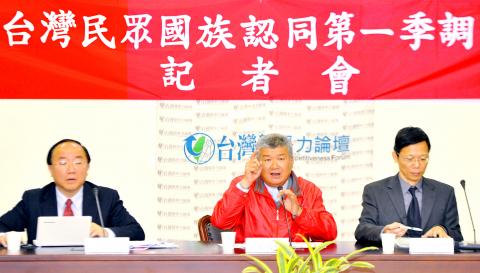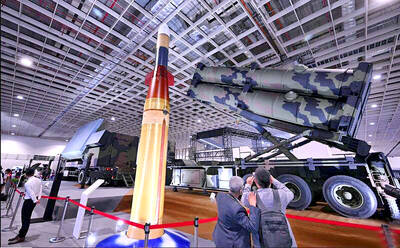Following recent meetings between former Chinese Nationalist Party (KMT) chairman Lien Chan (連戰) and Chinese leaders and their joint advocacy of a “one China” policy, a Want Want China Times Group-owned polling firm yesterday called for more emphasis on Chinese national identity in media coverage.
Representatives from the polling firm, Apollo Survey and Research Co Ltd, and Taiwan Competitiveness Forum, a think tank led by academics known for their pro-unification stance, yesterday released a survey asking Taiwanese about their perception of connections with China.
Describing the results of the survey as “astonishing,” they said that respondents showed a “very high degree of identification with China, Chinese and Zhonghua minzu (中華民族, Chinese ethnic group),” adding that media outlets should not make an issue of whether people in Taiwan identify themselves as Taiwanese, but should focus on Taiwanese identification with China.

Photo: Chen Chih-chu, Taipei Times
Chiu Yuan-bao (邱源寶), an Apollo executive, said the results of the survey were in sharp contrast with those conducted by National Chengchi University’s Election Study Center on behalf of the Mainland Affairs Council (MAC) over the past 20 years.
“This was the first survey of its kind, but we will continue to monitor whether there has been a major shift in national identity toward China,” Chiu said.
The survey showed that 90.4 percent of respondents gave a positive answer to a question asking them if they thought they were members of Zhonghua minzu who share common kinship, language, history and culture.
Asked if they are Chinese, 61.1 percent of respondents said yes, 35.4 percent said no and 3.6 percent did not have an opinion, the survey showed.
On a question in which respondents were given four choices, 25.6 percent said they are Taiwanese and also Chinese, 12.7 percent said they are Taiwanese but could also be Chinese, 28.2 percent said they are Taiwanese but do not deny that they are also Chinese, and 29.2 percent said they are Taiwanese and are not Chinese.
Asked “how they defined ‘one China’ under China’s assertion that Taiwan and China belong to one China and are both part of China,” 31.1 percent defined “one China” as Zhonghua minzu, 21.8 percent said “one China” refers to the Republic of China (ROC), 5.3 percent said it referred it to the People’s Republic of China (PRC), and 31.1 percent found the concept of “one China” unacceptable.
Meanwhile, asked “how they defined ‘one China’ under President Ma Ying-jeou’s (馬英九) assertion that it refers to the so-called ‘1992 consensus,’ which means ‘one China, with each side having its own interpretation,’” 34 percent defined “one China” as Zhonghua minzu, 23.7 percent said “one China” refers to the ROC, 4.7 percent said it is the PRC and 26.8 percent opposed the concept of “one China.”
The survey found that 67.4 percent of respondents thought that China should be seen more as an opportunity than a threat, while 25.7 percent thought the opposite.
Among those who view China as an opportunity, 14.9 percent said Taiwan should actively engage China, while 52.2 percent said Taiwan should engage China with caution.
In the group that sees China as a threat, 18.7 percent said that Taiwan should be cautious in dealing with China, and 7.2 percent opposed engagement with China.
The survey was conducted on Wednesday and Thursday nights last week by telephone with a random sampling of 1,092 people nationwide and a margin of error of plus or minus 3 percentage points.
When the first survey about Taiwanese national identity was released by the MAC in 1992, 46.4 percent of respondents identified themselves as both Taiwanese and Chinese, 25.2 percent as Chinese and 17.6 percent as Taiwanese.
The latest MAC survey released in December showed that the percentage of respondents who said they are both Taiwanese and Chinese decreased to 38.5 percent, while those who said they are Taiwanese rose to 54.3 percent. Only 3.65 percent said they are Chinese.
More than 20 years of democratic development has made most people identify with Taiwan, said Thomas Peng (彭錦鵬), a National Taiwan University political scientist.
“There’s no point in asking a person if he or she is a Taiwanese or suspecting one’s loyalty to Taiwan. On the contrary, media should place more emphasis on Chinese identity, the ROC and Zhonghua minzu because the survey has found that the belief that culture and kinship ties play an undeniable role in cross-strait relations is ingrained in society,” Peng said.

Taiwan is to commence mass production of the Tien Kung (天弓, “Sky Bow”) III, IV and V missiles by the second quarter of this year if the legislature approves the government’s NT$1.25 trillion (US$39.78 billion) special defense budget, an official said yesterday. Commenting on condition of anonymity, a defense official with knowledge of the matter said that the advanced systems are expected to provide crucial capabilities against ballistic and cruise missiles for the proposed “T-Dome,” an advanced, multi-layered air defense network. The Tien Kung III is an air defense missile with a maximum interception altitude of 35km. The Tien Kung IV and V

The disruption of 941 flights in and out of Taiwan due to China’s large-scale military exercises was no accident, but rather the result of a “quasi-blockade” used to simulate creating the air and sea routes needed for an amphibious landing, a military expert said. The disruptions occurred on Tuesday and lasted about 10 hours as China conducted live-fire drills in the Taiwan Strait. The Civil Aviation Administration (CAA) said the exercises affected 857 international flights and 84 domestic flights, affecting more than 100,000 travelers. Su Tzu-yun (蘇紫雲), a research fellow at the government-sponsored Institute for National Defense and Security Research, said the air

Taiwan lacks effective and cost-efficient armaments to intercept rockets, making the planned “T-Dome” interception system necessary, two experts said on Tuesday. The concerns were raised after China’s military fired two waves of rockets during live-fire drills around Taiwan on Tuesday, part of two-day exercises code-named “Justice Mission 2025.” The first wave involved 17 rockets launched at 9am from Pingtan in China’s Fujian Province, according to Lieutenant General Hsieh Jih-sheng (謝日升) of the Office of the Deputy Chief of the General Staff for Intelligence at the Ministry of National Defense. Those rockets landed 70 nautical miles (129.6km) northeast of Keelung without flying over Taiwan,

A strong continental cold air mass is to bring pollutants to Taiwan from tomorrow, the Ministry of Environment said today, as it issued an “orange” air quality alert for most of the country. All of Taiwan except for Hualien and Taitung counties is to be under an “orange” air quality alert tomorrow, indicating air quality that is unhealthy for sensitive groups. In China, areas from Shandong to Shanghai have been enveloped in haze since Saturday, the ministry said in a news release. Yesterday, hourly concentrations of PM2.5 in these areas ranged from 65 to 160 micrograms per cubic meter (mg/m³), and pollutants were